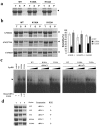Protein solubility and folding enhancement by interaction with RNA
- PMID: 18628952
- PMCID: PMC2444022
- DOI: 10.1371/journal.pone.0002677
Protein solubility and folding enhancement by interaction with RNA
Abstract
While basic mechanisms of several major molecular chaperones are well understood, this machinery has been known to be involved in folding of only limited number of proteins inside the cells. Here, we report a chaperone type of protein folding facilitated by interaction with RNA. When an RNA-binding module is placed at the N-terminus of aggregation-prone target proteins, this module, upon binding with RNA, further promotes the solubility of passenger proteins, potentially leading to enhancement of proper protein folding. Studies on in vitro refolding in the presence of RNA, coexpression of RNA molecules in vivo and the mutants with impaired RNA binding ability suggests that RNA can exert chaperoning effect on their bound proteins. The results suggest that RNA binding could affect the overall kinetic network of protein folding pathway in favor of productive folding over off-pathway aggregation. In addition, the RNA binding-mediated solubility enhancement is extremely robust for increasing soluble yield of passenger proteins and could be usefully implemented for high-throughput protein expression for functional and structural genomic research initiatives. The RNA-mediated chaperone type presented here would give new insights into de novo folding in vivo.
Conflict of interest statement
Figures





References
-
- Frydmann J. Folding of newly translated proteins in vivo: the role of molecular chaperones. Annu Rev Biochem. 2001;70:603–647. - PubMed
-
- Hartl FU, Hayer-Hartl M. Molecular chaperones in the cytosol: from nascent chain to folded protein. Science. 2002;295:1852–1858. - PubMed
-
- Kerner MJ, Naylor DJ, Ishihama Y, Maier T, Chang HC, et al. Proteome-wide analysis of chaperonin-dependent protein folding in Escherichia coli. Cell. 2005;122:209–220. - PubMed
-
- Vorderwülbecke S, Kramer G, Merz F, Kurz TA, Rauch T, et al. Low temperature or GroEL/ES overproduction permits growth of Escherichia coli cells lacking trigger factor and DnaK. FEBS Lett. 2004;559:181–187. - PubMed
Publication types
MeSH terms
Substances
LinkOut - more resources
Full Text Sources
Other Literature Sources

